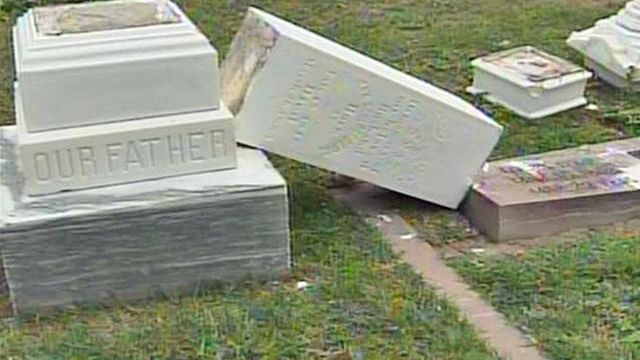Restoration brings life to vandalized cemetery
A vandal damaged more than 100 tombstones in Fayetteville's Cross Creek Cemetery. Some graves dated to the 1780s, and others belong to Confederate soldiers. But a dedicated preservationist is helping rescue that history.
Posted — UpdatedDean Ruedrich has taken a personal interest in the contract given to his Louisburg-based company, Ruedrich Restorations, to repair 28 headstones at Cross Creek Cemetery.
"Seeing them down, broken and walked on, it's frustrating not to be able to fix them all," Ruedrich said.
Lanny Ray Marler II, 29, was convicted of damaging more than 100 grave sites at Cross Creek between Aug. 11 and 14, 2006. Marler is in prison for violating his probation, according to state Department of Correction records.
Some of the vandalized tombstones date to the 1780s. Cross Creek is Fayetteville's oldest municipal cemetery and a national historic site.
A nurse, Anna K. Kyle, and other Fayetteville women raffled off homemade quilts to raise funds for North Carolina's oldest Confederate Memorial, erected in the cemetery in 1868.
Some older tombstones bear detailed accounts of the lives of the people buried there.
Pointing to two restored grave markers, Ruedrich referred to one by name: "Both of these were pushed over flat. Charles broke in half."
Dismayed by the desecration, city leaders voted to pay for the repairs. Ruedrich Restorations received $10,000 for its work – half from the city, half from the state Department of Cultural Resources.
The city also paid a marble company $7,600 to fix numerous markers that did not require as much restoration. Officials said more repairs are likely as funds become available.
In the meantime, though, Ruedrich said he couldn't stand to leave some graves still damaged, so he volunteered to repair a few more.
"To get him put and straightened and to leave her lying on the ground just didn't seem right," Ruedrich said.
Restoring old gravestones is part art, part science. Repairs to a single headstone can take from five hours to a full day.
Stainless steel rods are placed through the broken headstones, and a special epoxy applied to join the broken sections. The rods fasten the headstone back to its base, which sometimes has to be replaced.
The stones are cleaned of any extra epoxy, and a sealer – made of mortar to match the texture and appearance of a marble tombstone – fills in the cracks. The sealer is scraped smooth and excess washed off.
Heavily damaged tombstones, or those of poor quality marble, are framed with wood to keep them stable during repairs.
Crews use a hoist and chains to get heavier tombstones upright. Often, workers have to dig a new hole to keep the tombstone level.
Ruedrich said the lines on the grave of a Civil War veteran inspire him to keep on with the repair work. The words were composed by George Lauder, a famous Scottish stonecutter who also worked on the State Capitol.
"His last words to his comrades as they sadly gathered around him were, 'Press on, my brave boys. Follow up our glorious victory. Don't wait for me,'" Ruedrich read.
• Credits
Copyright 2024 by Capitol Broadcasting Company. All rights reserved. This material may not be published, broadcast, rewritten or redistributed.





